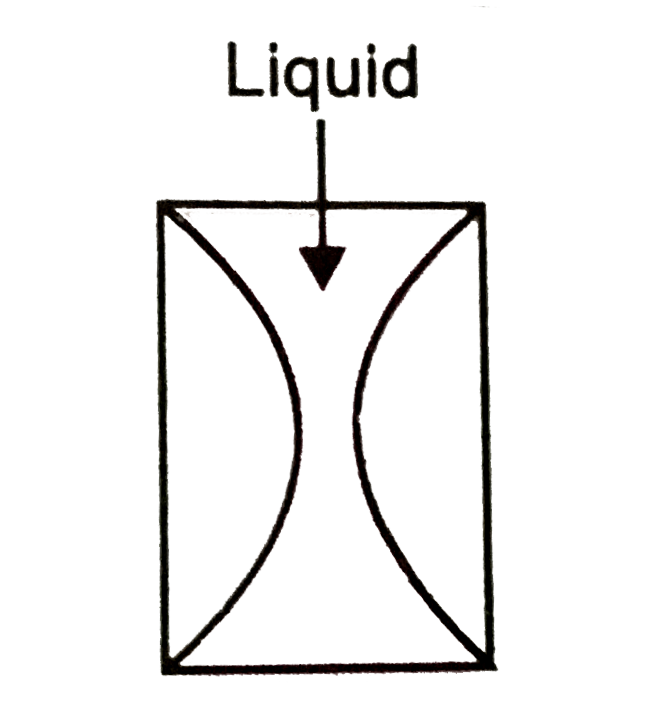The radii of curvature of both the surfaces of a lens are equal. How will its focal length and power change if one of the surfaces of the lens is made plane ?
To solve the problem, we need to analyze how the focal length and power of a lens change when one of its surfaces is made plane. Let's break it down step by step.
1. Understanding the Lens Configuration:
- Initially, we have a lens with two surfaces, both having equal radii of curvature, denoted as R1=R and R2=−R (the negative sign indicates the curvature direction).
2. Using the Lens Maker's Formula:
- The lens maker's formula is given by:
1F=(n−1)(1R1−1R2)
- Here, n is the refractive index of the lens material.
3. Calculating the Focal Length for the Original Lens:
- Substituting R1 and R2:
1F=(n−1)(1R−1−R)=(n−1)(1R+1R)=(n−1)(2R)
- Thus, the focal length F is:
F=R2(n−1)
4. Modifying the Lens by Making One Surface Plane:
- If we make one surface plane, we set R2 to infinity. So, now we have R1=R and R2=∞.
5. Calculating the New Focal Length:
- Using the lens maker's formula again:
1F′=(n−1)(1R1−1R2)=(n−1)(1R−0)=n−1R
- Therefore, the new focal length F′ is:
F′=Rn−1
6. Comparing the Focal Lengths:
- We see that:
F′=2F
- This indicates that the new focal length is double the original focal length.
7. Calculating the Power of the Lens:
- The power P of a lens is defined as:
P=1F
- Therefore, the original power P is:
P=2(n−1)R
- The new power P′ after making one surface plane is:
P′=1F′=1Rn−1=n−1R
- Since F′=2F, we find that:
P′=P2
Summary of Results:
- The focal length doubles when one surface of the lens is made plane.
- The power of the lens is halved.
- Initially, we have a lens with two surfaces, both having equal radii of curvature, denoted as R1=R and R2=−R (the negative sign indicates the curvature direction).
- The lens maker's formula is given by:
1F=(n−1)(1R1−1R2)
- Here, n is the refractive index of the lens material.
- Substituting R1 and R2:
1F=(n−1)(1R−1−R)=(n−1)(1R+1R)=(n−1)(2R)
- Thus, the focal length F is:
F=R2(n−1)
- If we make one surface plane, we set R2 to infinity. So, now we have R1=R and R2=∞.
- Using the lens maker's formula again:
1F′=(n−1)(1R1−1R2)=(n−1)(1R−0)=n−1R
- Therefore, the new focal length F′ is:
F′=Rn−1
- We see that:
F′=2F
- This indicates that the new focal length is double the original focal length.
- The power P of a lens is defined as:
P=1F
- Therefore, the original power P is:
P=2(n−1)R
- The new power P′ after making one surface plane is:
P′=1F′=1Rn−1=n−1R
- Since F′=2F, we find that:
P′=P2
- The focal length doubles when one surface of the lens is made plane.
- The power of the lens is halved.
Topper's Solved these Questions
- BOOK - PRADEEPCHAPTER - RAY OPTICSEXERCISE - Conceptual problem(c)8videos
RAY OPTICS
- BOOK - PRADEEPCHAPTER - RAY OPTICSEXERCISE - Conceptual problem(d)14videos
RAY OPTICS
- BOOK - PRADEEPCHAPTER - RAY OPTICSEXERCISE - Solved Example(d)32videos
RAY OPTICS
- BOOK - PRADEEPCHAPTER - PROPERTIES OF BULK MATTEREXERCISE - Multiple choice questions7videos
PROPERTIES OF BULK MATTER
- BOOK - PRADEEPCHAPTER - SYSTEMS OF PARTICLES AND ROTATIONAL MOTIONEXERCISE - Assertion- Reason Type questions20videos
SYSTEMS OF PARTICLES AND ROTATIONAL MOTION
Similar Questions
Knowledge Check
- Question 1 - Select One
The radii of curvature of both the surfaces of a convex lens are equal. One of the surfaces is made plane by grinding. What is the new focal power of the lens ?
AP'=2BP'=P2CP'=√P2DP'=23P - Question 2 - Select One
The radii of curvature of the two surfaces of a lens are 20 cm and 30 cm and the refractive index of the material of the lens is 1.5. If the lens is concave -convex, then the focal length of the lens is
A24 cmB10 cmC15 cmD120 cm - Question 3 - Select One
The radii of curvature of the two surfaces of a lens are 20 cm and 30 cm and the refractive index of the material of the lens is 1.5. If the lens is concave -convex, then the focal length of the lens is
A24 cmB10 cmC20 cmD24cm
The radii of curvature of the surfaces of a double convex lens are 20cmand40cm respectively, and its focal length is 20cm. What is the refractive index of the material of the lens ?
View SolutionThe radii of curvature of the two surface of a lens are 20 cm and 30 cm and the refractive index of the material of the lens is 1.5 . If the lens is concave - convex, then the focal length of the lens is :
View SolutionThe radii of curvature of the two surfaces of a lens are 20cm and 30cm and the refractive index of the material of the lens is 1.5. If the lens is concave− convex, then the focal length of lens is
View SolutionIf in a plano-convex lens, the radius of curvature of the convex surface is 10 cm and the focal length of the lens is 30 cm , then the refractive index of the material of lens will be
View SolutionThe effective focal length of the lens combination shown in Fig. is −60cm. The radii of curvature of the curved surfaces of the plano-convex lenses are 12cm each and refractive index of the material of the lens is 1.5. The refractive index of the liquid is :
 .View Solution
.View Solution

